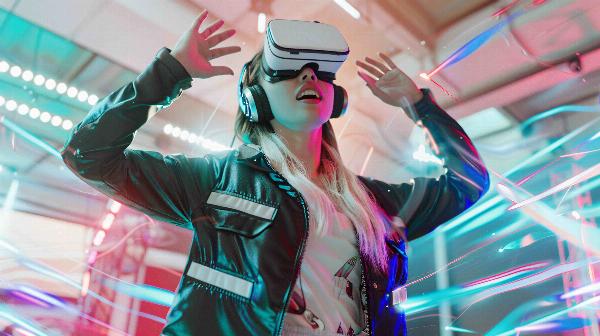What is Augmented Reality? Top 7 Applications of Augmented Reality

Strong 8k brings an ultra-HD IPTV experience to your living room and your pocket.
In recent years, augmented reality (AR) has emerged as a transformative technology, blending the digital and physical worlds to create immersive experiences. By overlaying digital content onto the real world, AR enhances our perception and interaction with the environment. This technology has far-reaching applications across various industries, revolutionizing the way we work, play, and learn. This article delves into the essence of AR and highlights the top seven applications that showcase its potential.
Understanding Augmented Reality
Augmented reality is a technology that superimposes computer-generated images, sounds, and other sensory inputs onto our real-world view. Unlike virtual reality (VR), which creates a completely immersive digital environment, AR enhances the real world with digital elements, allowing users to interact with both simultaneously. AR can be experienced through devices such as smartphones, tablets, AR glasses, and headsets.
Top 7 Applications of Augmented Reality
1. Education and Training
AR is transforming the education sector by making learning more interactive and engaging. Students can explore 3D models of historical landmarks, biological structures, and complex machinery, providing a deeper understanding of the subject matter. In professional training, AR can simulate real-world scenarios, enabling hands-on practice without the associated risks or costs.
2. Healthcare
In healthcare, AR is enhancing diagnostic and surgical procedures. Surgeons can use AR to visualize internal organs and tissues during operations, improving precision and reducing the risk of complications. Additionally, AR applications can assist in medical training, allowing students to practice procedures in a controlled, virtual environment.
3. Retail and E-commerce
AR is revolutionizing the retail industry by offering virtual try-ons and product visualizations. Customers can see how furniture will look in their home, try on clothes, or even test different makeup products, all from the comfort of their own space. This not only enhances the shopping experience but also reduces return rates and increases customer satisfaction.
4. Real Estate
Real estate professionals are leveraging AR to provide virtual tours of properties. Potential buyers can explore homes and commercial spaces in detail, even before visiting in person. AR can also be used to stage properties virtually, showcasing different furniture arrangements and interior designs to attract buyers.
5. Entertainment and Gaming
The entertainment industry has been one of the earliest adopters of AR. Popular games like Pokémon GO have demonstrated the potential of AR to create engaging and interactive experiences. AR is also being used in live events, theme parks, and museums to provide immersive storytelling and interactive exhibits.
6. Manufacturing and Maintenance
In the manufacturing sector, AR is being used to improve efficiency and accuracy. Technicians can access real-time information and instructions through AR glasses, enabling them to perform complex tasks with greater precision. AR can also assist in equipment maintenance by overlaying diagnostic data and repair instructions onto the machinery.
7. Navigation and Tourism
AR is enhancing navigation systems by providing real-time information and directions overlaid on the real world. Tourists can use AR applications to explore new cities, with information about landmarks, restaurants, and attractions displayed on their screens. This enriches the travel experience and helps users discover hidden gems.
Key Components of AR
Hardware: Gadgets such as tablets, smartphones, AR glasses, and specific AR headsets.
Software: Programs and systems created to analyze and present digital information in real-world settings.
Sensors: Include accelerometers, gyroscopes, and GPS to track the user’s movement and position.
Content: Digital elements, including images, texts, videos, and 3D models, are used to augment the real world.
Types of AR
Marker-based Augmented Reality: Uses image recognition to detect predefined markers in the environment to trigger digital overlays.
Markerless Augmented Reality: uses accelerometers, digital compasses, velocity meters, and GPS to deliver location-based augmented reality experiences.
Projection-based Augmented Reality: Projects digital light onto physical surfaces, which can be seen and interacted with in real-time.
Superimposition-based Augmented Reality: replaces, either entirely or partially, the existing vision with an enlarged one.
Applications of Augmented Reality
Retail: Allows customers to visualize products in their home environment before purchase.
Healthcare: Facilitates enhanced imaging and diagnostic procedures.
Education: Engages students with interactive and immersive learning experiences.
Gaming: Offers interactive entertainment through augmented environments.
Augmented Reality technology continues to evolve, driving innovations across various industries and transforming how society interacts with the digital world.
How Augmented Reality Works
Real-time integration of digital data with the user’s surroundings is known as augmented reality or Augmented Reality. This technology enhances the experience of the actual world by overlaying computer-generated images, sounds, and other sensory enhancements. Several core components and technologies underlie how AR functions:
Hardware Components
Display Devices: These include mobile devices, Augmented Reality glasses, and headsets that project digital content onto the physical world.
Sensors and Cameras: These capture real-world information to enable the Augmented Reality system to understand the environment.
Processing Unit: A processor to interpret sensor data and render augmented reality content in real-time.
Key Technologies
Simultaneous Localization and Mapping (SLAM): SLAM algorithms help augmented reality devices map the physical environment and track their own location within it.
Depth Tracking: Utilizes sensors, such as infrared, to understand the distance between the AR device and various objects in the physical world.
Object Recognition: Uses machine learning algorithms to identify and track objects in real time, allowing for more accurate overlays.
Tracking and Motion Sensors: Magnetometers, gyroscopes, and accelerometers monitor user motion and the augmented reality device’s orientation.
Software Components
AR SDKs and Frameworks: Software Development Kits like ARKit (iOS) and ARCore (Android) provide tools for developers to create augmented reality experiences.
3D Modelling Software: Creates the digital models and environments that are augmented into the real world.
Computer Vision Algorithms: Analyze and process images from the real world to align digital content accurately.
Workflow of AR Systems
Data Acquisition: Sensors and cameras collect real-world data.
Environmental Understanding: Software processes this data to map the environment and identify anchors for digital content.
Rendering: The AR system then renders the digital overlay, ensuring it aligns correctly with the physical world, adjusted for lighting, shadows, and perspective.
By leveraging these components and technologies, AR provides an immersive experience that enhances real-world engagement through interactive digital content.
Hardware and Software Requirements for AR
Augmented Reality (AR) relies on a seamless integration between hardware and software to create immersive experiences. Below are the key hardware and software components essential for AR functionality:
Hardware Requirements
Display Devices:
Smartphones and Tablets: Commonly used for AR applications due to built-in cameras and sensors.
Smart Glasses and Headsets: Devices like Microsoft HoloLens and Google Glass provide hands-free AR experiences.
Wearables: Devices such as AR-enabled watches can offer location-based AR applications.
Sensors:
Cameras: High-resolution cameras are necessary for capturing real-world images and video.
IMU Sensors (Inertial Measurement Units): Use magnetometers, gyroscopes, and accelerometers to track orientation and motion.
Depth Sensors: Essential for spatial mapping and object placement.
GPS: Crucial for location-based AR applications.
Processing Units:
CPUs (Central Processing Units): Must be powerful enough to handle complex AR computations.
GPUs (Graphics Processing Units): Required for rendering graphics-intensive AR experiences.
Connectivity:
Wi-Fi and Bluetooth: For data transfer and interaction with external devices.
5G Networks: Provide the necessary bandwidth and low latency for real-time AR applications.
Software Requirements
Operating Systems:
iOS and Android: The two primary operating systems with robust support for AR through ARKit (iOS) and ARCore (Android).
AR Development Platforms:
ARKit (Apple): Provides tools and APIs for developing AR apps on iOS.
ARCore (Google): Enables developers to build AR experiences on Android devices.
Unity and Unreal Engine: Popular game engines that offer extensive AR development support.
Frameworks and SDKs:
Vuforia: Augmented Reality software platform for creating interactive experiences.
Wikitude: Supports image recognition and tracking for AR applications.
3D Content Creation Tools:
Blender: Free and open-source 3D creation suite.
Maya: Comprehensive 3D modeling and animation software used by professionals.
Cloud Services:
AWS (Amazon Web Services): Provides scalable cloud computing resources for AR applications.
Microsoft Azure: Cloud services for building, testing, deploying, and managing AR apps.
Libraries and APIs:
OpenCV: open-source software library for machine learning and computer vision.
TensorFlow: Open-source platform for machine learning to enhance AR applications.
The right combination of hardware and software components is crucial for delivering effective, immersive AR experiences. The integration between these elements must be flawless to ensure a smooth and engaging user interaction.
Conclusion
Augmented reality is reshaping various industries by merging the digital and physical worlds in innovative ways. From education and healthcare to retail and entertainment, AR is enhancing our experiences and transforming how we interact with our environment. To explore more about the fascinating world of AR and its applications, visit What is Augmented Reality? Top 7 Applications of AR.
Note: IndiBlogHub features both user-submitted and editorial content. We do not verify third-party contributions. Read our Disclaimer and Privacy Policyfor details.


